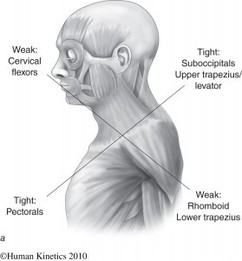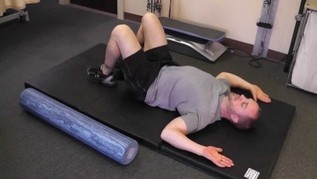Upper cross syndrome is characterized by tightness in the chest and the upper back/neck and weakness in the mid back and the front of the neck, hence the ‘cross’ part of the name. This syndrome can cause several different problems in the body and can lead you to be more prone to injuries. Continue reading to find out more about UCS and the simple test you can try at home to see if you have it.

- Forward head posture
- Increased cervical lordosis (neck curve)
- Increased thoracic kyphosis (hunch back type posture)
- Elevated and rolled forward shoulders
- Shoulder instability, dysfunction and pain
- It can cause mid back tension and pain
- Increased risk of rotator cuff injuries
- Rib joint dysfunction
- Neck pain
- Headaches
A simple test for Upper Cross Syndrome
There are two simple tests you can try at home to test for UCS. They are called the standing wall angel or the floor angel.
Standing Wall Angel
Stand with the back against a wall, have your feet slightly in front of the wall and have your head, buttocks and upper back/shoulders touching the wall. Bring your hands up into the 90-90 (‘don’t shoot’) position and try to have the arm, wrist and back of the hand touching the wall. Try and keep your mid-back flat against the wall.
Ideally you should be able to have your mid back flat against the wall, and have your forearms and hands flat against the wall. Your wrist should be less than 1cm from the wall. There should be no pain in this position. NOTE: In people that have UCS, they will often cheat in this test by flaring the rib cage out in order to increase the motion of the shoulders. This is why it is important to try and keep the mid back flat against the wall.
Floor Angel
The test can also be done lying on the ground on your back, this is called the floor angel. This version is often a bit easier as it uses gravity to help get in the position. Have your arms in the same, 90-90, position and let them fall back towards the ground. Ideally your wrist should be flat on the ground or at the most 1cm off the ground. Once again, it is important that when lying on your back, make sure your ribcage and lower back is not arched up in the air in order to increase the motion of your arms and shoulders. The image below shows the Floor Angel position. The standing wall angel is the same position except you are leaning against a wall.
Have you tried the test? Are your arms and hands flat on the ground? Or are they held up in the air due to tight muscles?
If you are arms are off the ground or the gap under your wrist in more than 1cm, then you probably have Upper Cross Syndrome. The important question you are probably asking is, if I have UCS, what can I do to fix it?
In part 2 of this post I will show you how to go about fixing or reducing UCS. True postural change requires 4 things to happen.
- You need to know what proper posture feels like.
- You need to free up restricted joints.
- You need to reduce the soft tissue tension.
- Finally, you need to strengthen the appropriate muscles.
Stay tuned for my next post that will go over these 4 things and give you some useful tips to try at home. In the meantime, try to keep a 'good posture' as much as you can, your body will thank you for it.




 RSS Feed
RSS Feed


